Are you one of those who take their pets to professional groomers? Then, you have probably missed having fun and adventures with your Fido. Grooming a dog at home can be a rewarding and bonding experience for both the owner and the dog. However, it can also be challenging and time-consuming, especially for beginners.
That’s why it is important to learn the basics of how to groom a dog properly. Grooming a dog is not only a way to keep them looking good but also a way to keep them healthy, comfortable and happy. Grooming a dog involves brushing, bathing, clipping and trimming its fur and nails.
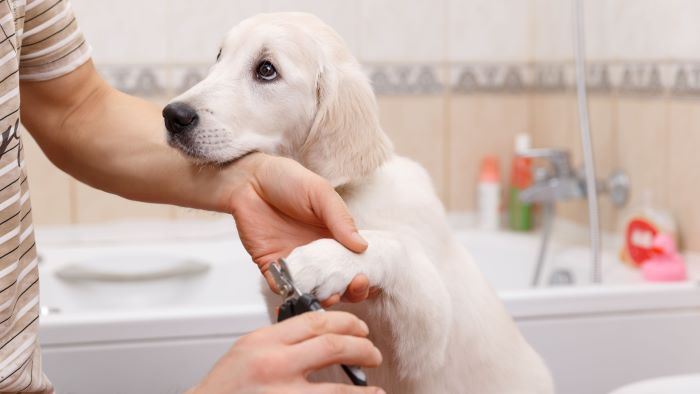
Let us dive in and explore how to groom a dog. Let’s make grooming fun and easy for you and your dog. By following these steps, you will be able to give your dog a professional-looking and stress-free grooming at home.
How to Groom a Dog?
Getting yourself a dog means taking care of his well-being as well as hygienic needs. Regularly grooming your dog will not only make him look good but also keep the dog away from bacteria and infection. Dog grooming is very important to examine the coat, eyes, ears and skin of the dog for any signs of problems.
Dogs do not require everyday grooming sessions. They need grooming once a week or sometimes once a month depending on the dog’s breed, length of coat and activity level.[1] Professional groomers and vets are well-trained in handling the dog, however, you can also build the expertise to groom your dog at home. But, how to groom a dog?
Well, grooming a dog includes bathing the dog, cleaning his ears, eyes and nose, trimming his nails and brushing his coat regularly. You can keep your dog happy, healthy and odour-free by following the grooming tips at home.
Grooming the Eyes, Ears and Nose
You can clean the face of your dog separately after bathing. This is because the face is a sensitive part of the body. Even the mildest dog shampoo can affect the eyes and ears of the dog which can lead to infection and allergies. Thus, it is advisable to look out for the face area later.
Eyes
The dirt particles and crust from tears tend to collect below the eyes. You can use a wet, soft cloth to clean the area around the eyes. Simultaneously, you should check for any signs of redness or swelling in your Fido’s eyes too.
The eyes should be moist. If not, then it can affect the dog’s ability to see. You can use eye drops to moisten the eyes or consult your vet for the same.
Ears
With a damp cloth wipe the flaps of the ears. You can also use cotton balls soaked in mineral oil and gauze to clean the ears. Dirt and wax collect in your dog’s ears too, just like ours. You should clean your dog’s ears once a month and more frequently if they’re prone to ear problems. Never force anything into the ear.
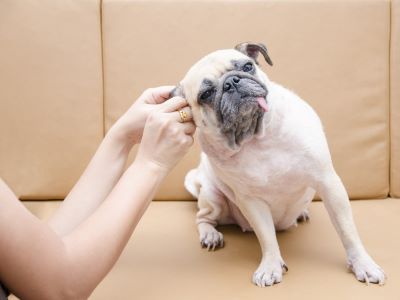
Some dogs require the hair just inside the ear to be plucked to promote proper airflow and reduce the risk of ear infections. Your veterinarian can examine your dog’s ears and determine if this is necessary for your furry friend’s optimal health.
Nose
The nose of a dog is the most ignored part while grooming. The nose should remain moist most of the time. Though it becomes dry at some part of the day like after nap time, it should not persist throughout the day.
If your dog’s nose feels dry, It could be due to dry air, dehydration, sunburn or other reasons. Provide your dog with plenty of water and ensure the room they are in is humid enough. You can also use high-quality nose palm or paw balm to protect the nose.
Brushing the Dog’s Teeth
Use toothbrushes and toothpaste specially designed for dogs to brush their teeth. Clean their teeth regularly and frequently, at least once or twice a week. Do not use human toothpaste on your dog’s teeth.
Dogs develop bad breath if their teeth are not cleaned regularly. Make sure to provide chew toys that will help clean their teeth. As your dog gets older, it may have a buildup of tartar that requires special cleaning by a veterinarian.[2]
Brushing the Coat
Just like we comb our hair every day, dogs too need to brush their fur to get shiny and healthy coats. However, you may not need to brush their coats every day. For long-haired breeds like golden retrievers or Hounds will require brushing once a week whereas short-haired breeds like labradors need to brush once every other week.
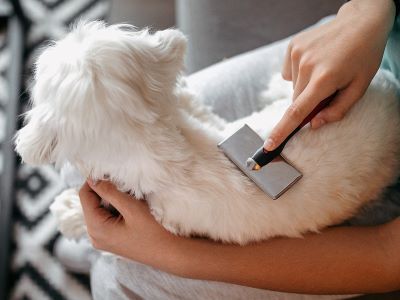
Follow these steps to get a shiny, healthy coat for your dog:
- You can start with the head, move down slowly and end up brushing the tail.
- Be careful with parts under the belly and around the anal sacs as these are sensitive parts of the body.
- When brushing a long-haired dog, be sure to gently work out any tangles that you find.
- Do not burn the skin by combing harshly at the same place.
- You can check by looking under the fur to see if the skin becomes red with irritation.
You can brush short-haired dogs with simple tools while using more specialized tools like a steel comb, slicker, pin brush, or an undercoat rake for medium to long-haired dogs. Apart from matting, regular brushing removes loose hair, dirt and dander from your dog’s coat and distributes the body oils evenly.
When brushing a long-haired dog breed like a Cockapoo, having a good set of clippers like the best dog clippers for cockapoo can make things much easier.
Matted Hair
Many dogs have badly matted hair that causes pain and irritation. Regular combing will ensure that the dogs do not develop such hair. A thorough combing should always be the first step of the grooming process because any mats will become tighter and less manageable once they dry.
You might have observed your dog licking and biting himself. A dog will lick or bite himself at the source of irritation, which may result in skin infections. Foreign bodies like grass seeds can hide inside a matted coat and can even burrow into the skin to cause an abscess.
Bathing the Dog
Depending on the breed, your dog should have regular, yet not frequent baths. This is because too frequent baths can wash off the natural oils and make the skin dry and harsh. It can also affect the quality of the coat.
Bathing is crucial to keep the dog healthy and happy. Bathe a long-haired breed once every four to six weeks whereas short-haired breeds or hairless breeds need more frequent baths. Hence, it is important to know how often should you bathe a dog.
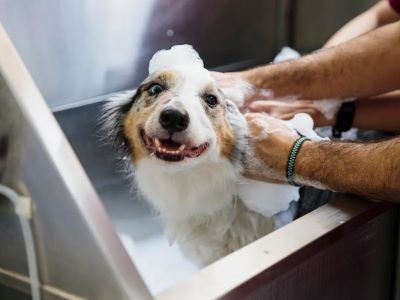
Gather the supplies:
- Dog shampoo
- Towels
- Treats
- Dog favourite toys
Firstly, you need to place the dog in a bathtub or a basin and wet him with lukewarm water. Never use too cold or too hot water. Begin at the neck and move downward toward the rear and legs, using your fingers to spread the shampoo and work it down to the skin.
After bathing your dog, you’ll need to lift them out of the tub. Learn how to lift a dog with a towel properly to keep them calm and secure
Save the head for last, and don’t use soap around the ears and eyes. Instead, use a wet towel or washcloth to clean the head. Finally, rinse the dog and pat him dry using a towel. You can also use a dryer if needed. Blow-drying can dry the coat without overheating or over-drying your dog.
Grooming the Nails and Paw Pads
The nails of a dog grow in a curved shape. If left untrimmed, the claws will eventually curve under the dog’s paws and dig into the skin. This will hurt the dog while walking. Long nails can not only damage the floor and furniture of the house but can also hurt the dog.
The nails should be trimmed in such a way that it does not hurt the quick. Nerves in the quick cause bleeding and discomfort when cut. If your dog is comfortable with the use of clippers then it would be the most efficient and quickest way to shorten their nails.
Professional groomers use clippers to trim the nails of a dog. However, clipping nails is a tricky task and a slight mistake can give your dog a painful injury. Thus, many pet parents ask how to keep dog nails short without clipping.
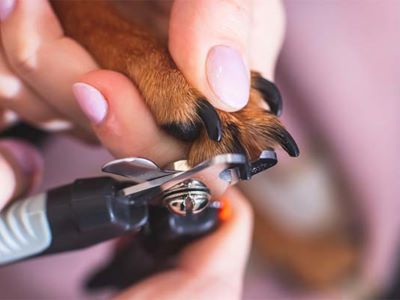
After an outdoor walk, when the paws of your dog are not too dirty then you can clean them without water using a paper towel or a wet wipe. Otherwise, you can even wash the paws using water and a little dog shampoo to get rid of muddy sticky paws.
You can also apply paw balm to moisturize, protect and heal them. It can help prevent and treat common paw problems. It can also provide a soothing effect for your dog and prevent them from licking or biting their paws.
If new to nail trims, check our guide on how to cut dog nails for more information.
Additional Advice and Warning
Grooming your Fido at home can increase the bonding between both of you. It can also be fun and adventurous for both. However, you should attempt to groom your dog only if you are trained. One mistake and you will hurt your dog which you don’t want to.
What to do:
- Always use the right tools. Grooming tools vary from age to breed of dogs. They are different for short-haired and long-haired breeds and they also include a brush for combing the coat. Thus, you should ask a professional groomer for the same.
- Brush your Fido every other day to remove dirt and debris, prevent matting, control shedding and create a shiny coat.
- Use a damp cloth to remove dirt particles from your dog’s coat and clean ears, eyes and nose.
- Clean the paw pads regularly and check for injuries or cracks on the paw pads. Trim excessive hair around the paws as it may add to difficulty while walking.
- Keep the nails trimmed. This will not only avoid scratches on floors and furniture but also avoid injuries and bleeding to your dog.
- While grooming your dog, check for skin rashes, irritation, ear infection, paw injury or eye swelling. Grooming is just another way to have a close look at your pet and consult a veterinarian if necessary.
- Always use vet-approved medicines and products for your pet.
Regularly maintaining your dog clippers by sharpening the blades is key for efficiency. Learning how to sharpen dog clipper blades properly will allow you to keep them in optimal condition for grooming
What not to do:
- Never use human products on your dog.[3]
- Never use a clipper to trim the nails unless you are fully trained.
- Do not try to clip or shave your dog’s hair by yourself without proper training.
- Do not bathe your dog outdoors.
- Do not attempt to express your dog’s anal sacs yourself.
Investing in high-quality grooming supplies like the best dog drying towel UK can make the process easier and more pleasant for both you and your dog
FAQs
How do you groom a dog for the first time?
Start with nails. Trim them up to the perfect size. Gradually clean their eyes, ears and nose. You can also cut the matted hair if you are trained enough. Finally, give a cool bath to the dog and apply dog-friendly products to promote a healthy shiny coat.
Do you cut dog hair before or after a bath?
Give your dog a bath and let him dry thoroughly before you clip him. You should avoid clipping a dirty dog if at all possible. This is because the dirt will clog the clippers and make your job difficult. A clean dog will make the trimming and cutting job easy for you.
How often should you bathe your dog?
Medium and long-coat dogs should bathe every four to six weeks and owners of dogs with short coats should bathe their pets somewhere between every month and every three months. Dog owners should be warned not to wash their pup’s coats too much, though.
Why does it take many hours to groom a dog?
A normal bath and drying may only take an hour for most dogs. But dogs with dense, double, and water-resistant coats, such as Huskies, Akitas and Newfoundlands, may take up to three hours to dry and longer to de-shed. Dogs with thicker coats, such as Samoyeds or Malamutes, may take longer.
How to Groom a Dog? — An Overview
So, how to groom a dog? Grooming a dog is an essential part of caring for your furry friend. It helps them maintain a clean and healthy coat, skin, nails, ears, and eyes. It also helps them feel more comfortable and confident. Grooming a dog at home can be fun and easy if you know how to do it right.
Remember to always be gentle, patient, and positive with your dog during the grooming process. Reward them with praise, treats, and cuddles for their good behaviour. And don’t forget to enjoy the quality time you spend with your dog. 🐶
References:
- Mmyers. (2022b, June 16). Time For A Summer Cut? Tips For Warm Weather Dog Grooming. VMBS News by Texas A&M University.
- Enlund, K. B., Pettersson, A., & Eldh, A. C. (2022). Dog owners’ ideas and strategies regarding dental health in their Dogs-Thematic Analysis of Free Text Survey responses. Frontiers in Veterinary Science.
- Anthropomorphism and its adverse effects on the distress and welfare of companion animals. MDPI.



